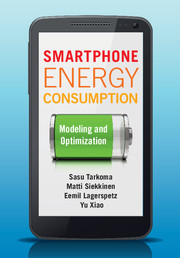Book contents
- Frontmatter
- Contents
- Preface
- List of abbreviations
- Part I Understanding energy consumption
- Part II Energy management and conservation
- Part III Advanced energy optimization
- 11 Overview
- 12 Traffic scheduling
- 13 Exploiting multiple wireless network interfaces
- 14 Mobile cloud offloading
- 15 Example scenarios for energy optimization
- 16 Future trends
- Appendix A An energy profile application
- Index
11 - Overview
from Part III - Advanced energy optimization
Published online by Cambridge University Press: 05 August 2014
- Frontmatter
- Contents
- Preface
- List of abbreviations
- Part I Understanding energy consumption
- Part II Energy management and conservation
- Part III Advanced energy optimization
- 11 Overview
- 12 Traffic scheduling
- 13 Exploiting multiple wireless network interfaces
- 14 Mobile cloud offloading
- 15 Example scenarios for energy optimization
- 16 Future trends
- Appendix A An energy profile application
- Index
Summary
We have so far learned the principles of how smartphones and their different components consume energy. We have also looked at the power-management mechanisms that are employed with the hardware components. Examples of such mechanisms include DVFS to scale the CPU power draw with the workload, and the use of sleep state and discontinuous reception to optimize the energy consumption due to wireless communication.
In this part, we take a look at a set of mechanisms to reduce energy consumption that are built on top of the existing power-management techniques. In this chapter, we first describe the nature and necessity of these mechanisms on a high level after which we briefly introduce the different classes of solutions.
Underlying power-management techniques alone are not enough
Although almost all the hardware contained in modern smartphones has certain kinds of in-built power-management mechanism, usually the whole device still consumes more energy than would strictly be necessary unless another layer of optimization mechanisms is employed. That slightly counter-intuitive observation stems from three main observations:
The hardware components are not perfectly power proportional to the offered load.
The energy utility of the different subsystems, especially of wireless communication, is context dependent.
The underlying hardware power-management mechanisms are rarely optimal for the applications being used.
- Type
- Chapter
- Information
- Smartphone Energy ConsumptionModeling and Optimization, pp. 227 - 233Publisher: Cambridge University PressPrint publication year: 2014
- 1
- Cited by



